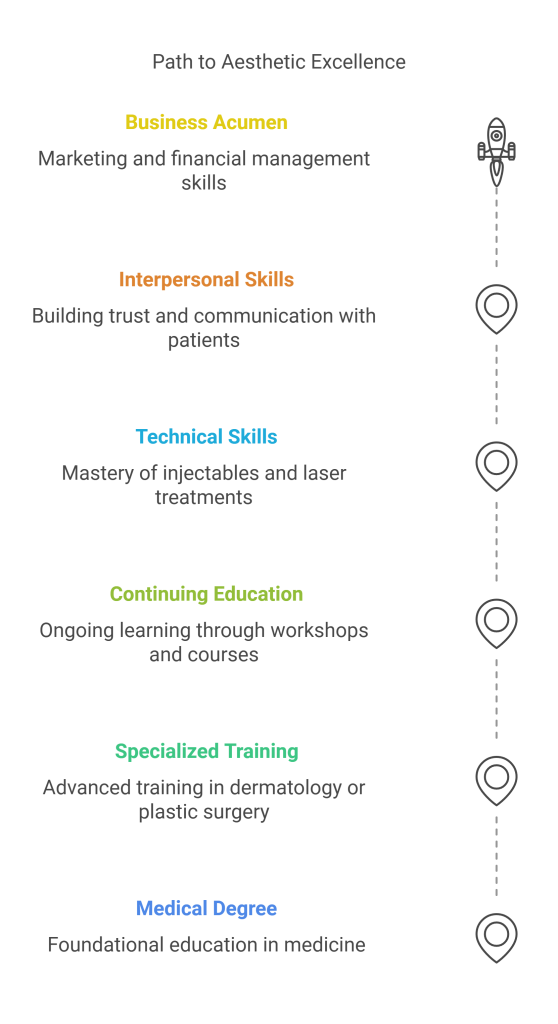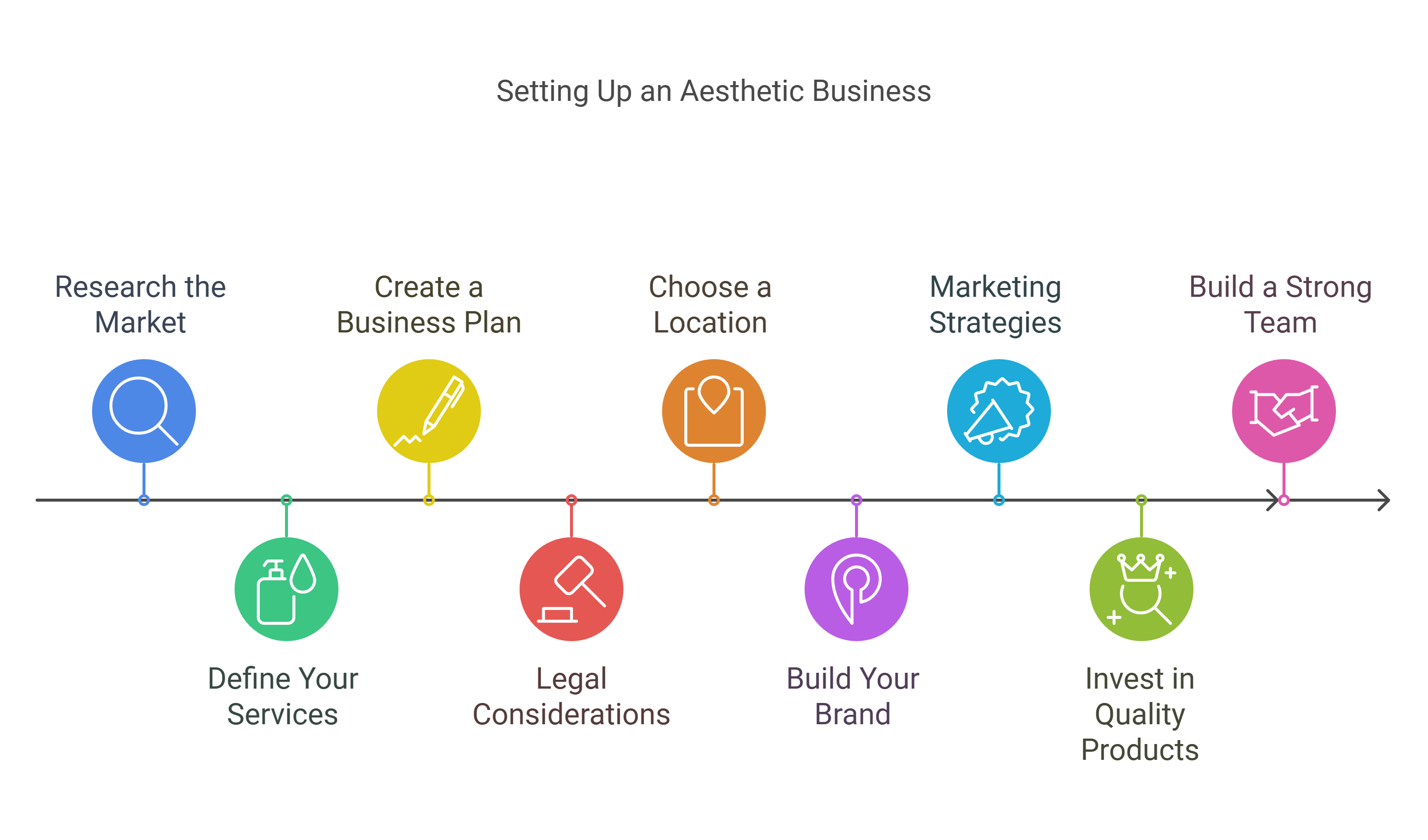Starting Your Own Aesthetic Business

Table of Contents
ToggleThinking about diving into the world of aesthetic businesses? You’re in the right place! From understanding what exactly an aesthetic business is to knowing the ins and outs of running one, this guide covers it all.
So if you’re curious about the necessary skills, legal considerations, or how to make your business stand out, we’ve got you covered. Let’s explore the fascinating realm of aesthetics together.
Key Takeaways
Aesthetic businesses focus on beauty treatments like skincare, hair removal, and more.
Key players include dermatologists, cosmetologists, and specialised clinics.
Continuous education is vital for staying updated with new techniques and trends.
Marketing through social media and influencers is crucial for visibility.
Legal compliance, including necessary registrations, is essential for operation.
Understanding the Aesthetic Business Landscape
An aesthetic business revolves around enhancing physical appearance through non-surgical treatments. These businesses offer services like Botox, dermal fillers, laser treatments, and skin rejuvenation.
The focus is on improving clients’ confidence by addressing cosmetic concerns without invasive procedures. This sector is not just about beauty; it’s about wellness and self-care, appealing to a broad audience seeking subtle yet effective enhancements.
Key Players in the Industry
The aesthetic industry is populated by a variety of professionals, including:
Medical Practitioners: Doctors and nurses who provide treatments with a medical background.
Aesthetic Therapists: Specialists trained in non-medical procedures like facials and skin treatments.
Product Manufacturers: Companies producing the equipment and products used in treatments.
These players collaborate to deliver comprehensive services, ensuring clients receive safe and effective treatments.
Market Trends and Growth
The aesthetic market is booming, driven by trends such as:
Regenerative Procedures: Treatments that harness the body’s healing abilities, like PRP (Platelet-Rich Plasma) therapy.
Prerejuvenation: Targeting younger demographics with preventative treatments to maintain youthful skin.
Men’s Aesthetics: A growing number of men are seeking treatments, expanding the market demographic.
Aesthetic businesses must stay informed about these trends to remain competitive. Attending industry events and engaging with professional networks can provide valuable insights into evolving consumer preferences.
In a world where appearance and wellness are increasingly intertwined, the aesthetic business landscape offers exciting opportunities for growth and innovation. Staying ahead of trends and understanding client needs are key to thriving in this dynamic industry.
For those looking to enhance their clinic’s reach, This Aesthetic Marketing Hub provides expert insights into attracting new clients and boosting business growth.
Essential Skills and Qualifications for Aesthetic Practitioners

Required Certifications and Training
Entering the world of aesthetics is about having the right qualifications in place. To offer treatments safely and legally, practitioners often need a Level 6 qualification, such as a Bachelor’s degree in a healthcare-related field. Those aiming to administer injectables like Botox may require a Level 7 Post-Graduate Diploma in Aesthetic Medicine.
Additionally, registration with bodies like the Nursing and Midwifery Council (NMC) or the General Medical Council (GMC) is often necessary.
Importance of Continuous Education
Staying updated with the latest techniques and treatments is crucial. Continuous education ensures practitioners remain competent and confident in their skills. Many professionals attend workshops and advanced courses, not just to learn new techniques, but to refine their existing skills. This ongoing learning process is vital for maintaining high standards of care.
Building Client Trust Through Expertise
Clients seek assurance that they are in capable hands. Building trust starts with demonstrating expertise and professionalism. Practitioners should focus on clear communication, explaining procedures and setting realistic expectations.
A well-informed client is a satisfied client, often leading to repeat visits and referrals. By consistently delivering quality care and staying informed about industry advancements, practitioners can foster a loyal client base.
“In aesthetics, your qualifications speak volumes, but your skills and ongoing commitment to learning truly set you apart.”
Legal and Regulatory Considerations in Aesthetic Business
In the UK, the Care Quality Commission (CQC) is a key player in ensuring that health services, including certain aesthetic treatments, meet the required standards. If you’re running an aesthetic clinic, knowing whether your services require CQC registration is crucial.
Generally, clinics offering surgical or medical treatments, like Botox or fillers, need to be registered. This registration not only ensures compliance but also boosts your clinic’s credibility in the eyes of clients.
Compliance with Industry Standards
Compliance isn’t just about ticking boxes; it’s about maintaining a high standard of care and safety. Here are a few things to consider:
Regular Audits: Conducting regular audits helps ensure that all procedures and protocols meet industry standards.
Staff Training: Continuous training is vital to keep up with the latest techniques and safety practises.
Patient Records: Keeping detailed and accurate records not only helps in compliance but also in delivering personalised care.
Legal Implications of Non-Compliance
Failing to comply with regulations can lead to severe consequences. Clinics might face hefty fines, or even closure, if found operating without necessary registrations or violating industry standards.
Non-compliance doesn’t just risk legal action; it can damage your reputation and trust with clients. Ensuring your clinic adheres to UK regulations with a comprehensive compliance checklist safeguards both your practise and your patients.
In summary, staying on top of legal and regulatory requirements is not just about avoiding penalties but about ensuring the safety and satisfaction of your clients.
Marketing Strategies for Aesthetic Businesses
Leveraging Social Media Platforms
Social media is not just a tool but a necessity for aesthetic businesses. Platforms like Instagram, Facebook, and TikTok are perfect for showcasing your work. Visual content is key here—think before-and-after photos, client testimonials, and even live treatment sessions to engage potential clients. It’s not just about posting; interaction is crucial. Respond to comments, engage with followers, and use stories to keep your audience updated.
Importance of Client Testimonials
Client testimonials are gold in the aesthetic industry. Potential clients often rely on the experiences of others before making a decision. Encourage satisfied clients to leave reviews on platforms like Google and your social media pages.
Display these testimonials prominently on your website and in your marketing materials. A well-placed testimonial can be the deciding factor for someone considering your services.
Effective Use of Influencer Collaborations
Collaborating with influencers can significantly expand your reach. Choose influencers whose audience aligns with your target demographic. This partnership can take many forms, from sponsored posts to live events at your clinic. It’s essential to maintain authenticity—select influencers who genuinely resonate with your brand and can speak to the quality of your services.
In a competitive market, standing out is about more than just offering quality services—it’s about building a brand that clients trust and want to engage with. Your marketing strategy should reflect your clinic’s values and strengths, attracting clients who appreciate what you offer.
Setting Up Your Aesthetic Business

Choosing the Right Location
When setting up an aesthetic business, picking the right spot is like finding the perfect pair of shoes. It needs to fit well and be comfortable. Think about your target customers. Are they city dwellers or suburbanites?
Consider a place that’s easy for them to get to. High foot traffic areas can be great, but they might cost more. On the flip side, a quieter area might be cheaper but could mean fewer walk-ins. Balancing cost and visibility is key.
Investing in Quality Equipment
Once you’ve nailed down where you’ll be, it’s time to think about what you’ll need. The equipment you choose can make or break your business. High-quality tools mean better results and happier clients.
Look into the latest tech and make sure everything meets industry standards. Don’t forget about the little things like comfy chairs and soothing lighting. They all add up to a better experience for your clients.
Creating a Business Plan
A solid business plan is your roadmap. It helps you see where you’re going and how you’ll get there. Start by outlining your goals and how you plan to reach them. Include details about your target market, pricing, and financial projections.
Think about how you’ll market your services and manage day-to-day operations. This plan isn’t just for you; it’s for potential investors too. They want to see you’ve thought things through.
Setting up an aesthetic business is a journey. It takes careful planning and a bit of guts. But with the right location, top-notch equipment, and a clear business plan, you’re well on your way to success.
If you’re considering setting up an aesthetics business as a sole trader, it might be the quickest and simplest option for you. This path is often chosen by aesthetic nurses, therapists, and practitioners. It’s worth exploring if you want to get started without too much hassle.
Enhancing Client Experience in Aesthetic Clinics

Personalised Treatment Plans
Creating a personalised treatment plan is like crafting a bespoke suit—it needs to fit just right. Every client is unique, and they want to feel like their needs are understood and catered to. Start by having a detailed consultation where you listen to their concerns and goals.
Customising treatments not only makes clients feel special but also boosts their satisfaction with the results. It’s about showing them that you’ve considered their individual needs and not just offering a one-size-fits-all solution.
Importance of Customer Service
Customer service is the backbone of any successful aesthetic clinic. Imagine walking into a clinic and being greeted with a warm smile and a friendly chat—instantly, you feel at ease. Train your staff to be attentive and approachable.
It’s not just about the treatments; clients remember how they were treated from the moment they walk in the door. Good service can turn a one-time visitor into a loyal customer who keeps coming back and even recommends your clinic to friends.
Utilising Feedback for Improvement
Feedback is gold. Whether it’s a glowing review or a constructive critique, it’s an opportunity to learn and improve. Encourage your clients to share their thoughts after treatments. You can do this through follow-up emails, texts, or even a quick chat during their next visit.
Use this feedback to tweak your services and address any issues. It’s all about mastering the customer journey to make sure every client leaves happy and satisfied.
“In the world of aesthetics, the client experience is everything. It’s not just about looking good—it’s about feeling valued and understood.”
By focusing on these areas, aesthetic clinics can create a welcoming environment that clients will love and want to return to. It’s about building relationships and trust, ensuring every visit is a positive experience.
Financial Planning and Management for Aesthetic Businesses
Budgeting and Forecasting
Running an aesthetic business without a solid financial plan is like sailing without a compass. Budgeting is your financial roadmap, guiding you through the ups and downs of the industry. Start by listing all your expected expenses, from rent and utilities to supplies and marketing. Then, estimate your income based on your current client base and potential growth. Adjust this budget monthly to reflect your actual earnings and expenses.
Forecasting is the next step. Look at market trends and past performance to predict future income. This helps you plan for slow seasons and allocate resources effectively. Remember, being conservative in your estimates can prevent overspending and ensure a financial cushion for unexpected costs.
Managing Operational Costs
Keeping your operational costs in check is crucial for maintaining profitability. Regularly review your expenses and identify areas where you can cut costs without compromising quality. This might mean negotiating better rates with suppliers or finding more efficient ways to manage your clinic.
Consider these tips:
Automate administrative tasks to save time and reduce labour costs.
Invest in energy-efficient equipment to lower utility bills.
Review your inventory regularly to avoid overstocking and waste.
Maximising Profitability
To maximise profitability, focus on both increasing revenue and reducing costs. Upselling and cross-selling to existing clients can boost income without the need for additional marketing spend. For example, offering a discount on a package of treatments can encourage clients to commit to more sessions.
Also, consider diversifying your services to attract a wider client base. Keep an eye on emerging trends and new technologies in the aesthetic industry to stay competitive.
Financial management isn’t just about cutting costs; it’s about making smart decisions that help your business grow sustainably. Embrace the numbers, and let them guide you to success.
By mastering these financial strategies, your aesthetic business can thrive even in challenging economic times. For more in-depth knowledge on financial management and other essential skills for aesthetic clinics, consider enrolling in a specialised course that covers all these aspects comprehensively.
Future Trends in the Aesthetic Industry

Technological Advancements
The aesthetic digital industry is on the brink of a tech revolution. Innovations in AI and machine learning are reshaping how treatments are delivered. AI-driven diagnostic tools are becoming more common, allowing for personalised treatment plans that cater to individual needs.
Moreover, 3D printing is making waves, especially in creating bespoke prosthetics and implants. Virtual reality is also being explored for training purposes, offering practitioners a risk-free environment to hone their skills.
Emerging Treatment Techniques
New treatment methods are continually emerging, driven by consumer demand for less invasive options. Regenerative medicine, which uses the body’s natural healing processes, is gaining traction. Techniques like platelet-rich plasma (PRP) therapy and stem cell treatments are becoming more popular. Additionally, there’s a growing interest in “prerejuvenation,” where younger clients seek preventative treatments to delay signs of ageing.
Sustainability in Aesthetics
The push for sustainability isn’t just a fad; it’s becoming a core part of the aesthetic industry. Brands are now focusing on eco-friendly packaging and sustainable ingredients. Clinics are also adopting greener practises, such as reducing energy consumption and waste. This shift not only appeals to environmentally conscious consumers but also sets a new standard for industry practises.
As we look to the future, the aesthetic industry is poised to blend cutting-edge technology with sustainable practises, meeting the needs of a diverse and demanding clientele.
Conclusion
In a nutshell, an aesthetic business is all about enhancing beauty and confidence through various treatments and services. Whether you’re considering starting one or just curious, it’s clear that the industry is booming. With the right mix of skills, marketing, and dedication, you can carve out a successful niche.
Remember, it’s not just about the treatments; it’s about creating a welcoming space where clients feel valued and cared for. So, if you’re ready to dive in, the world of aesthetics awaits with open arms. Just make sure to keep learning and adapting as trends evolve. Good luck on your journey!
Frequently Asked Questions
What is an aesthetic business?
An aesthetic business is a place where people go to get beauty treatments. These treatments can help improve skin, make you look younger, or just make you feel good about yourself.
Who can work in an aesthetic business?
People who work in aesthetic businesses often need special training. They might be doctors, nurses, or beauty therapists. They must know how to do treatments safely.
Do you need a license to run an aesthetic business?
In some places, you need a license to run an aesthetic business. This helps make sure the business follows rules and keeps clients safe.
What are some popular treatments in aesthetic businesses?
Popular treatments include facials, Botox, and laser hair removal. These treatments help with skin care, reducing wrinkles, and removing unwanted hair.
How do aesthetic businesses attract clients?
Many businesses use social media to show their work and attract clients. They might also use client reviews and work with influencers to reach more people.
Why is customer service important in aesthetic businesses?
Good customer service makes clients feel welcome and valued. Happy clients are more likely to return and tell their friends about the business.









